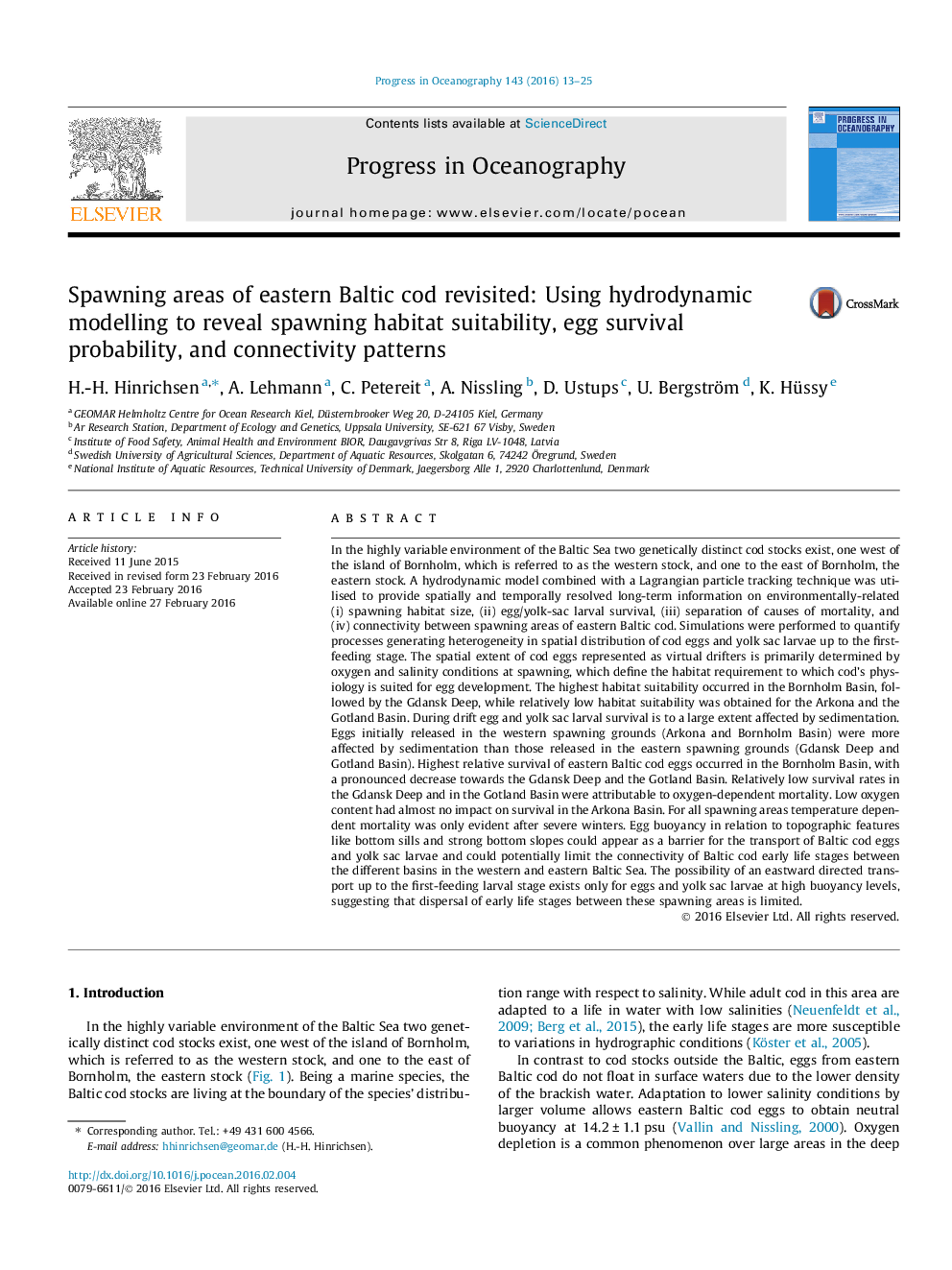| کد مقاله | کد نشریه | سال انتشار | مقاله انگلیسی | نسخه تمام متن |
|---|---|---|---|---|
| 6388340 | 1627915 | 2016 | 13 صفحه PDF | دانلود رایگان |
عنوان انگلیسی مقاله ISI
Spawning areas of eastern Baltic cod revisited: Using hydrodynamic modelling to reveal spawning habitat suitability, egg survival probability, and connectivity patterns
ترجمه فارسی عنوان
مناطقی از مناطق نواحی دریای بالتیک بالتیک: استفاده از مدل سازی هیدرودینامیکی برای نشان دادن مناسب بودن زیستگاه های تخم ریزی، احتمال زنده ماندن تخم مرغ و الگوهای ارتباط
دانلود مقاله + سفارش ترجمه
دانلود مقاله ISI انگلیسی
رایگان برای ایرانیان
موضوعات مرتبط
مهندسی و علوم پایه
علوم زمین و سیارات
زمین شناسی
چکیده انگلیسی
In the highly variable environment of the Baltic Sea two genetically distinct cod stocks exist, one west of the island of Bornholm, which is referred to as the western stock, and one to the east of Bornholm, the eastern stock. A hydrodynamic model combined with a Lagrangian particle tracking technique was utilised to provide spatially and temporally resolved long-term information on environmentally-related (i) spawning habitat size, (ii) egg/yolk-sac larval survival, (iii) separation of causes of mortality, and (iv) connectivity between spawning areas of eastern Baltic cod. Simulations were performed to quantify processes generating heterogeneity in spatial distribution of cod eggs and yolk sac larvae up to the first-feeding stage. The spatial extent of cod eggs represented as virtual drifters is primarily determined by oxygen and salinity conditions at spawning, which define the habitat requirement to which cod's physiology is suited for egg development. The highest habitat suitability occurred in the Bornholm Basin, followed by the Gdansk Deep, while relatively low habitat suitability was obtained for the Arkona and the Gotland Basin. During drift egg and yolk sac larval survival is to a large extent affected by sedimentation. Eggs initially released in the western spawning grounds (Arkona and Bornholm Basin) were more affected by sedimentation than those released in the eastern spawning grounds (Gdansk Deep and Gotland Basin). Highest relative survival of eastern Baltic cod eggs occurred in the Bornholm Basin, with a pronounced decrease towards the Gdansk Deep and the Gotland Basin. Relatively low survival rates in the Gdansk Deep and in the Gotland Basin were attributable to oxygen-dependent mortality. Low oxygen content had almost no impact on survival in the Arkona Basin. For all spawning areas temperature dependent mortality was only evident after severe winters. Egg buoyancy in relation to topographic features like bottom sills and strong bottom slopes could appear as a barrier for the transport of Baltic cod eggs and yolk sac larvae and could potentially limit the connectivity of Baltic cod early life stages between the different basins in the western and eastern Baltic Sea. The possibility of an eastward directed transport up to the first-feeding larval stage exists only for eggs and yolk sac larvae at high buoyancy levels, suggesting that dispersal of early life stages between these spawning areas is limited.
ناشر
Database: Elsevier - ScienceDirect (ساینس دایرکت)
Journal: Progress in Oceanography - Volume 143, April 2016, Pages 13-25
Journal: Progress in Oceanography - Volume 143, April 2016, Pages 13-25
نویسندگان
H.-H. Hinrichsen, A. Lehmann, C. Petereit, A. Nissling, D. Ustups, U. Bergström, K. Hüssy,
